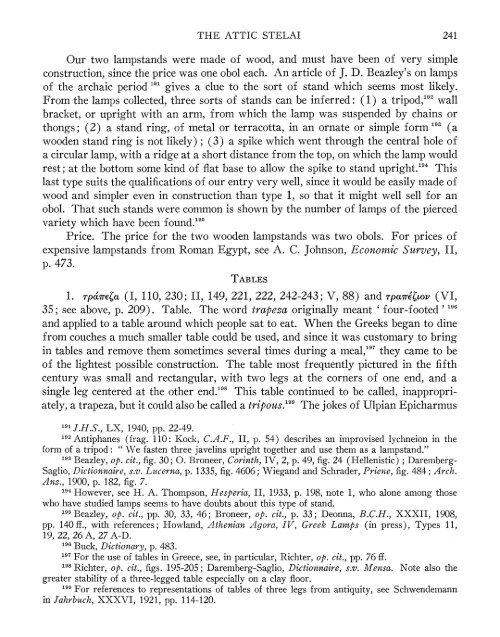the attic stelai - The American School of Classical Studies at Athens
the attic stelai - The American School of Classical Studies at Athens
the attic stelai - The American School of Classical Studies at Athens
You also want an ePaper? Increase the reach of your titles
YUMPU automatically turns print PDFs into web optimized ePapers that Google loves.
THE ATTIC STELAI 241<br />
Our two lampstands were made <strong>of</strong> wood, and must have been <strong>of</strong> very simple<br />
construction, since <strong>the</strong> price was one obol each. An article <strong>of</strong> J. D. Beazley's on lamps<br />
<strong>of</strong> <strong>the</strong> archaic period 191 gives a clue to <strong>the</strong> sort <strong>of</strong> stand which seems most likely.<br />
From <strong>the</strong> lamps collected, three sorts <strong>of</strong> stands can be inferred: (1) a tripod,192 wall<br />
bracket, or upright with an arm, from which <strong>the</strong> lamp was suspended by chains or<br />
thongs; (2) a stand ring, <strong>of</strong> metal or terracotta, in an orn<strong>at</strong>e or simple form 93 (a<br />
wooden stand ring is not likely); (3) a spike which went through <strong>the</strong> central hole <strong>of</strong><br />
a circular lamp, with a ridge <strong>at</strong> a short distance from <strong>the</strong> top, on which <strong>the</strong> lamp would<br />
rest; <strong>at</strong> <strong>the</strong> bottom some kind <strong>of</strong> fl<strong>at</strong> base to allow <strong>the</strong> spike to stand upright.194 This<br />
last type suits <strong>the</strong> qualific<strong>at</strong>ions <strong>of</strong> our entry very well, since it would be easily made <strong>of</strong><br />
wood and simpler even in construction than type 1, so th<strong>at</strong> it might well sell for an<br />
obol. Th<strong>at</strong> such stands were common is shown by <strong>the</strong> number <strong>of</strong> lamps <strong>of</strong> <strong>the</strong> pierced<br />
variety which have been found.95<br />
Price. <strong>The</strong> price for <strong>the</strong> two wooden lampstands was two obols. For prices <strong>of</strong><br />
expensive lampstands from Roman Egypt, see A. C. Johnson, Economic Survey, II,<br />
p. 473.<br />
TABLES<br />
1. rpdirERa (I, 110, 230; II, 149, 221, 222, 242-243; V, 88) and rpac're4ov (VI,<br />
35; see above, p. 209). Table. <strong>The</strong> word trapes2 originally meant ' four-footed' 196<br />
and applied to a table around which people s<strong>at</strong> to e<strong>at</strong>. When <strong>the</strong> Greeks began to dine<br />
from couches a much smaller table could be used, and since it was customary to bring<br />
in tables and remove <strong>the</strong>m sometimes several times during a meal,197 <strong>the</strong>y came to be<br />
<strong>of</strong> <strong>the</strong> lightest possible construction. <strong>The</strong> table most frequently pictured in <strong>the</strong> fifth<br />
century was small and rectangular, with two legs <strong>at</strong> <strong>the</strong> corners <strong>of</strong> one end, and a<br />
single leg centered <strong>at</strong> <strong>the</strong> o<strong>the</strong>r end.198 This table continued to be called, inappropri<strong>at</strong>ely,<br />
a trapeza, but it could also be called a tripous.199 <strong>The</strong> jokes <strong>of</strong> Ulpian Epicharmus<br />
191 J.H.S., LX, 1940, pp. 22-49.<br />
192<br />
Antiphanes (frag. 110: Kock, C.A.F., II, p. 54) describes an improvised lychneion in <strong>the</strong><br />
form <strong>of</strong> a tripod: " We fasten three javelins upright toge<strong>the</strong>r and use <strong>the</strong>m as a lampstand."<br />
193 Beazley, op. cit., fig. 30; 0. Broneer, Corinth, IV, 2, p. 49, fig. 24 (Hellenistic); Daremberg-<br />
Saglio, Dictionnaire, s.v. Lucerna, p. 1335, fig. 4606; Wiegand and Schrader, Priene, fig. 484; Arch.<br />
Anz., 1900, p. 182, fig. 7.<br />
194 However, see H. A. Thompson, Hesperia, II, 1933, p. 198, note 1, who alone among those<br />
who have studied lamps seems to have doubts about this type <strong>of</strong> stand.<br />
195 Beazley, op. cit., pp. 30, 33, 46; Broneer, op. cit., p. 33; Deonna, B.C.H., XXXII, 1908,<br />
pp. 140 ff., with references; Howland, A<strong>the</strong>nian Agora, IV, Greek Lamps (in press), Types 11,<br />
19, 22, 26A, 27A-D.<br />
196 Buck, Dictionary, p. 483.<br />
197<br />
For <strong>the</strong> use <strong>of</strong> tables in Greece, see, in particular, Richter, op. cit., pp. 76 ff.<br />
198 Richter, op. cit., figs. 195-205; Daremberg-Saglio, Dictionnaire, s.v. Mensa. Note also <strong>the</strong><br />
gre<strong>at</strong>er stability <strong>of</strong> a three-legged table especially on a clay floor.<br />
199 For references to represent<strong>at</strong>ions <strong>of</strong> tables <strong>of</strong> three legs from antiquity, see Schwendemann<br />
in Jahrbuch, XXXVI, 1921, pp. 114-120.
















